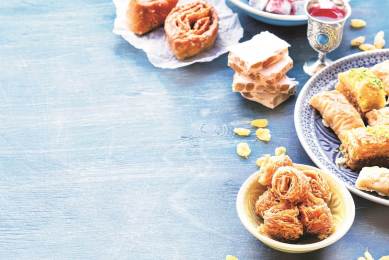Opening Hearts and Homes
As Eid-ul-Fitr draws near, and the sweet aromas of sevai fill the air, dip into the stories and recipes that have travelled generations.

In the excitement to be the first to spot the moon on chand raat, we would all run around in the lawn or on the terrace and sometimes even lie about having seen it,” says author and historian Rana Safvi. Filled with nostalgia, she recalls that Eid-ul-Fitr celebrations during her growing up years were a homespun affair. “Unlike Eid-ul-Zuha which is a sacrifice feast, Eid-ul-Fitr is celebrated after the trying month of Ramazan that teaches one to control one’s basic instincts. The triumph is then celebrated with a feast of sevai and other delicacies,” says Safvi. In her house, the women rustled up the traditional sevai while the men offered namaz, and the children eagerly awaited their share of eidi — a token gift given by the elders of the family.
Though the tradition continues, Safvi rues the change it has undergone in recent times. “Eid was one of the few occasions when we used to get gifts from our parents. Now, with an increase in the purchasing power, these gifts don’t mean as much.”
monthly limit of free stories.
with an Express account.
But what has remained unruffled by time’s passage is the Eid feast. Food entrepreneur and author Sadia Dehlvi recounts in her new book, Jasmine and Jinns: Memories and Recipes of My Delhi, the extravagant spread of Eid staples such as biryani, qorma, shaami kebab, dahi badey and sevai that the family would enjoy. “My aunt would make Aam Pulao with fresh sarauli mangoes. It’s a traditional recipe but few make it these days. I inherited the recipe from her and now I make it in addition to the traditional sevai,” says Dehlvi.
Indispensable to Eid-ul-Fitr is sheer qorma or vermicelli pudding which is served to guests who pass through the house, throughout the day. Historian Sohail Hashmi hosts about 50-60 people on Eid. “Sheer khurma and dahi badey are the main dishes that are served to those who visit us on the festival. They are also sent to neighbours, so naturally, the two dishes are made in abundance. The khurma is made with semolina vermicelli which we procure from Benaras because that is where the finest semolina vermicelli is found,” says Hashmi, “Incidentally, the dahi badey ka masala that we make at home is the same as the one that Mithan Halwai in Kashmiri Gate uses. When my grandmother was leaving for Pakistan, she told the halwai that his dahi badey would be greatly missed. In
an act of generosity, he shared his recipe with her that she later passed on to my mother, when she came to visit my parents in Delhi.”
Murg Musallam:
Ingredients:
Chicken, plucked and cleaned from inside
Ground onion paste 250 gm
Finely diced onion 1
Ginger garlic paste 2 tbsp each
Dhania powder 2 tbsp
Thick curd 1 cup
Garam masala 1 tbsp
Salt, chilli powder to taste
– Marinate chicken overnight in a marinade of ginger-garlic paste, ground onion paste, dhania powder, curd, garam masala, salt and chilli powder.
– Heat oil in a shallow lagana or kadhai where the full chicken can easily fit in.
– Pour in 1/2 cup oil
– Fry 1 finely diced onion in the oil till golden.
– Put the chicken on top of it and let it cool on each side for 15 minutes.
– Use two big spoons to turn it over to keep it intact.
– When done remove chicken on to a flat serving dish.
– Pour the roasted marinade on top.
– Garnish with sliced boiled eggs.
(Contributed by Rana Safvi)
Sheer Khurma
Ingredients:
Semolina sevai 50-70 gm
Milk 2 kg
Cloves 2-3
Ghee
Dry raisins 25-30 gm
Almonds– soaked overnight and julienned 50 gm
Sugar 6-8 tbsp
Green cardamom powdered
Kewra water
Method:
– Place a thick bottom pan on high flame and add ghee and cloves.
– Once they begin to splutter, add the sevai.
– Add the milk while stirring constantly till the milk begins to boil.
– As it changes colour, check if the sevai is cooked properly by pressing it between your fingers.
– Add the sugar and stir.
– Once the sugar is dissolved, turn off the gas and bring down to room temperature before refridgerating.
– Garnish with almonds, kewra water and powdered green cardamom.
– Serve cold.
Tip: While adding the sugar, keep in mind that the dish will taste sweeter when cold
(Contributed by Sohail Hashmi)
Aam Pulao – Mango Rice
Ingredients:
Basmati rice ½ kg
Ripe mangoes 750 gm
Khoya 500 gm
Green cardamoms 6
Desi ghee ¼ cup
Sugar or to taste 1 cup
Method:
– Soak the basmati rice in water for about 30- 45 minutes.
– Cook the rice till it is almost done.
– Meanwhile, hand crush or grate khoya and fry lightly till golden brown. No ghee is required as khoya releases ghee. – Peel the mangoes and cut them into 1-2’’ pieces.
– When the rice is dry and almost done, take another cooking utensil and spread a layer of rice over it.
– Spread the mango slices over the rice and sprinkle it with khoya and then sugar. Make one or two more such layers.
– Heat desi ghee in a separate pan and add the crushed cardamoms to it. Fry for a minute and then pour the ghee over the rice and mango layers.
– Cover and simmer for 10 to15 minutes on low flame till the rice is done. Do not stir as the rice grains should remain whole.
Tip: Any variety of mangoes can be used, but it tastes best with the fragrant alphonso, rataul and sarauli mangoes.
(Contributed by Sadia Dehlvi)